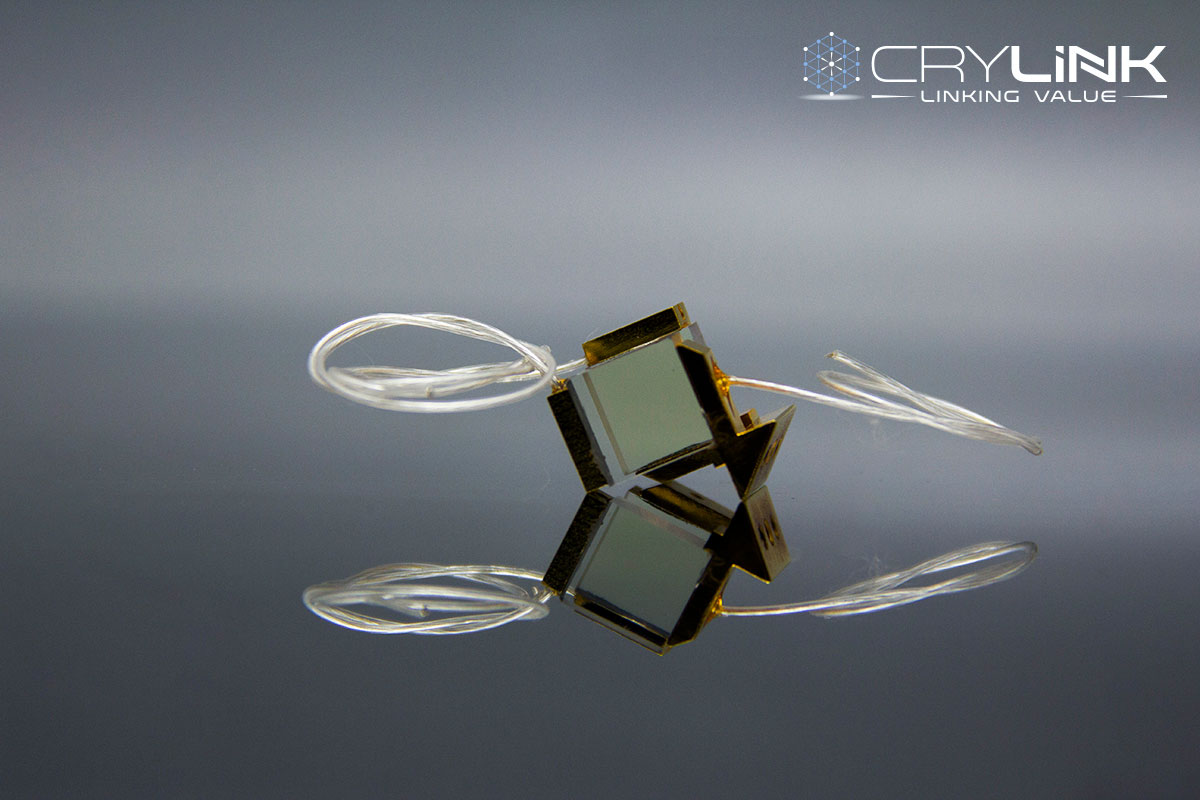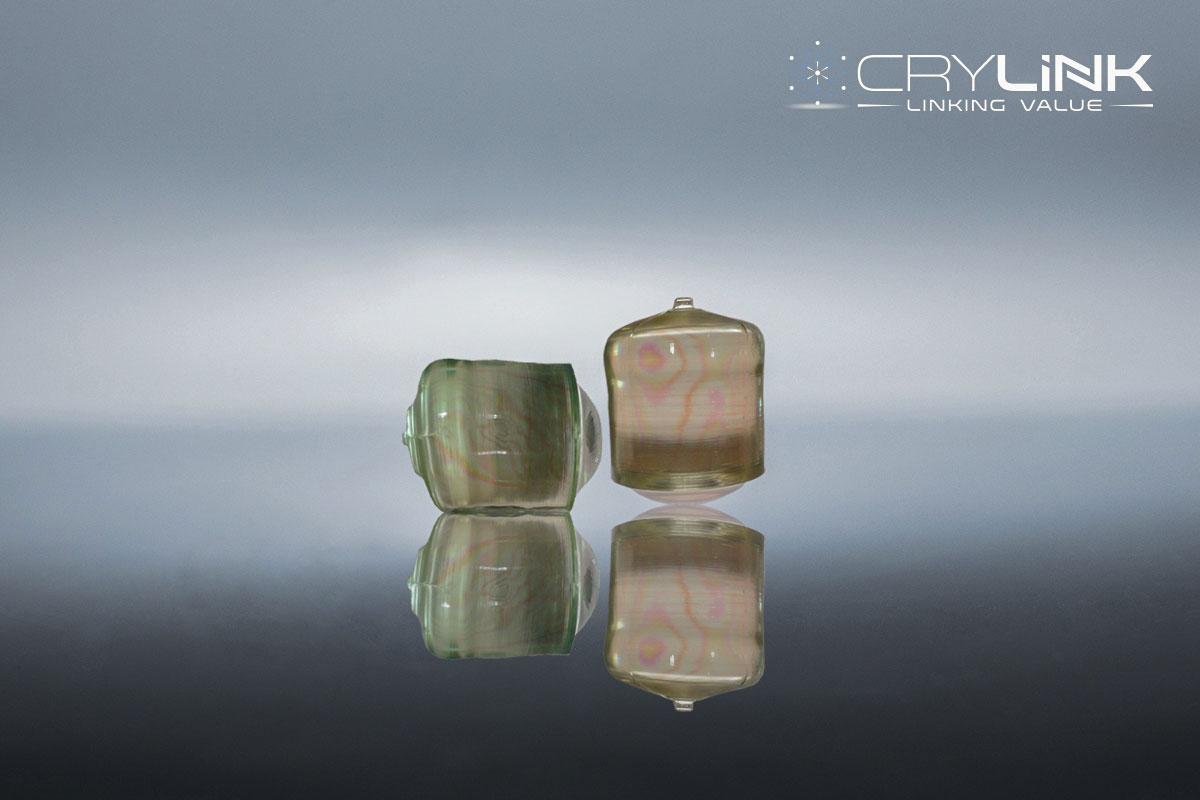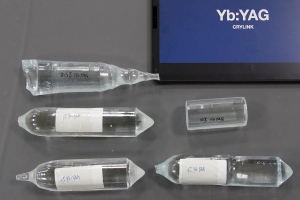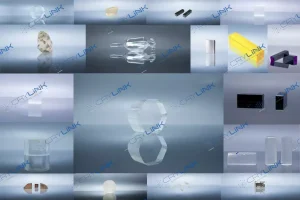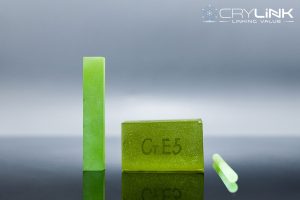KTP Crystal
KTP Electro-optical Q-switch Crystal—a crystal having a high electrooptic coefficient, a low dielectric constant, and capable of operating at high frequencies
The dielectric constant ε22 of KTP varies little with frequency and is not affected by the electric coupling effect under pressure. ε33 varies greatly with frequency and is not affected by the electrical coupling effect under pressure. Especially at high frequencies, ε22 and ε33 do not vary with frequency.Outside the 500kHz-10MHz region, electro-optic devices made with KTP crystals do not produce parasitic oscillations due to piezoelectric coupling, which are severe in other electro-optic crystals. The thermal hysteresis effect of KTP is much smaller and has high temperature stability.
532nm laser
Medical Applications:Evaluation of 532-nm KTP laser treatment efficacy on acne vulgaris
The 532-nm KTP laser is generated by using potassium titanium oxide phosphate (KTiOPO4) for frequency doubling of Nd:YAG laser radiation. This wavelength is appropriate for the treatment of superfi cial vascular and pigmented lesions and used for the treatment of both acne vulgaris and rosacea. For acne vulgaris, photoactivation of bacterial porphyrins, reduction of sebum production and collateral damage to sebaceous glands are the proposed mechanisms for its mode of action.
[Ref] Evaluation of 532-nm KTP laser treatment efficacy on acne vulgaris with once and twice weekly applications
Medical Applications:Application of potassium-titanyl-phosphate (KTP) laser in the excision of pyriform fossa hemangioma
Among lasers, the KTP-532 laser has several advantages that make it ideally suited for excision of hemangiomas. The potassium-titanyl-phosphate (KTP) laser has a wavelength in the visible light range (532 nm). It does not require an aiming beam and can be delivered via fiberoptic fibers. It is also preferentially absorbed by hemoglobin and, therefore, is effective in the treatment of vascular lesions. KTP-532 laser–assisted excision being a minimally invasive approach provides the advantage of minimal blood loss. The KTP-532 laser offers distinct advantages because it produces a zone of coagulation on either side of the incision, and as it cuts, it appears to seal the edges of the wounds. It is a quick, well-tolerated, minimally invasive procedure. An external incision and scar are avoided with this approach. It is a simple, safe, and effective surgical treatment with great potential in the future.
[Ref] Application of potassium-titanyl-phosphate (KTP) laser in the excision of pyriform fossa hemangioma
1 μm radiation of Nd lasers
modulators and Q-switches:KTiOPO4 (KTP) is a relatively new material that is widely used for frequency doubling the 1 μm radiation of Nd lasers.
Its high nonlinear optical d-coefficients, high optical damage threshold, wide acceptance angles and thermally stable phase matching properties make it useful for this purpose and, its large electrooptic r-coefficients and low dielectric constants make it attractive for various electrooptical applications such as modulators and Q-switches.
[Ref] Potassium Titanyl Phosphate (KTP):Properties, Recent Advances and New Applications
- Wide transparency range
- Stable mechanical and chemical properties
- Low conductivity
- highdamage threshold
- Not easy to deliquesce
- High temperature stability
- Large electro-optic coefficient
- Low half-wave voltage
- Easy to grow into large crystal
| Q-S witching and Frequency Doubling of Solid-state Lasers by a Single Intracavity KTP Crystal |
| Highly efficient doubling of a high-repetition-rate diode-pumped laser with bulk periodically poled KTP |
| Effect of dispersion on the operation of a KTP electro-optic Q switch |
| High average power KTiOPO4 electro-optic Q-switch |
If you can’t find the Literature you want, Contact us to get the PDF Get the Literature
| Tunable terahertz-wave generation in DAST crystal with dual-wavelength KTP optical parametric oscillator |
| Temperature Insensitive SHG at 0.5321 μm in KTP |
| Study of the plasma produced from laser ablation of a KTP crystal |
| Stabilization of a High-Power Diode-Side-Pumped Intracavity-Frequency-Doubled CW Nd:YAG Laser by Compensating for Thermal Lensing of a KTP Crystal and Nd:YAG Rods |
| Self-focusing and self-defocusing by cascaded second-order effects in KTP |
| Potassium Titanyl Phosphate (KTP):Properties, Recent Advances and New |
| Parametric Oscillation at 3.2 pm in KTP Pumped at 1.064 pm |
| Parametric oscillation and compression in KTP crystals |
| Optical Studies of Laser-Induced Gray-Tracking in KTP |
| Observation of azimuthal modulational instability and formation of patterns of optical solitons in a quadratic nonlinear crystal |
| Highly Efficient Intracavity Frequency Doubling 532nm Laser Based on the Gray Tracking Resistance KTP Crystal |
| Growth of large single crystals of KTiOPO4 (KTP) from high-temperature solution using heat pipe based furnace system |
| Generation of 740 mW of blue light by intracavity frequency doubling with a first-order quasi-phase-matched KTiOPO4 crystal |
| Generation and application of twin beams from an optical parametric oscillator including an a-cut KTP crystal |
| Frequency-tunable sum- and difference-frequency generation by using two diode lasers in a KTP crystal |
| Efficient second-harmonic generation in KTP crystals |
| Efficient Nd:YAG laser frequency doubling with periodically poled KTP |
| Efficient frequency doubling of a vertical-extended-cavity surface-emitting laser diode by use of a periodically poled KTP crystal |
| Efficient 532nm Laser Using High GrayTracking Resistance KTP Crystal |
| Dual-wavelength single-crystal double-pass KTP optical parametric oscillator and its application in terahertz wave generation |
| Compact and efficient 3.2-W diode-pumped Nd:YVO4yKTP green laser |
| Calculations of optimum phase match parameters for the biaxial crystal KTiOPO4 |
| Application of potassium-titanyl-phosphate (KTP) laser in the excision of pyriform fossa hemangioma |
| Absolute measurement of quadratic nonlinearities from phase-matched second-harmonic generation in a single KTP crystal cut as a sphere |
| 110 W high stability green laser using type II phase matching KTiOPO4 (KTP) crystal with boundary temperature control |
| Evaluation of 532-nm KTP laser treatment effi cacy on acne vulgaris |
Parameter
| Transparency range | 350-4500 nm |
| Crystal structure | Orthorhombic |
| Density | 3.01 g/cm3 |
| Mohs hardness | 5 |
| Absorption Coeffient | a < 1%/cm @1064 nm and 532 nm |
| Refractive indices | nx=1.7377, ny=1.7453, nz=1.8297 @ 1064 nm |
| nx=1.7780, ny=1.7886, nz=1.8887 @ 532 nm | |
| Sellmeier equations (λ, μm) | nx2=3.0065+0.03901/(λ2-0.04251)-0.01327λ2 |
| ny2=3.0333+0.04154/(λ2-0.04547)-0.01408λ2 | |
| nz2=3.3134+0.05694/(λ2-0.05658)-0.01682λ2 | |
| Thermal conductivity | 13 W/m/K |
| Therm-optic Coefficients (/℃) | dnx/dT=1.1*10-5 |
| dny/dT=1.3*10-5 | |
| dnz/dT=1.6*10-5 |
| Electro-optic coefficients | Low Frequency (pm/V) | High Frequency (pm/V) |
| r13 | 9.5 | 8.8 |
| r23 | 15.7 | 13.8 |
| r33 | 36.3 | 35 |
| r51 | 7.3 | 6.9 |
| r42 | 9.3 | 8.8 |
| Phase Matching Range | 980-3400 nm | |
| Flatness | Less than λ/8 @ 633 nm | |
| Wave front distortion | Less than λ/8 @ 633 nm | |
| Transmission surface parallelism | Less than 20″ | |
| Electrical conductivity | 3.5*10-8 s/cm (c-axis,22℃,1KHz) | |
| Dielectric constant | εeff=13 |
| Cell Parameters | a=6.404 Å, b=10.616 Å, c=12.814 Å, z=8.00 Å |
| Melting Point | 1172 ℃ |
| Curie Point | 936 ℃ |
| Specific Heat | 0.1643 cal/g℃ |
| Angle Acceptance SHG 1064 nm(mrad/cm) | 14.2 (Φ) 55.3 (θ) |
| Clear aperture | Centre 90% |
| Chamfering of edge | ≤0.2 mm@45° |
| Edge breakage | ≤0.1 mm |
| Surface smoothness | 10/5 |
| Side perpendicularity | ≤5′ |
| Angle tolerance | △θ≤0.25°, △ф≤0.25° |
| laser-damaged threshold: [GW/cm ] | >0.5 for 1064 nm, TEM00, 10 ns, 10 HZ (AR-coated) |
| >0.3 for 532 nm, TEM00, 10 ns, 10 HZ (AR-coated) |


